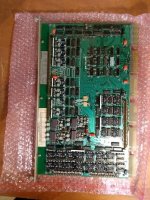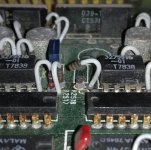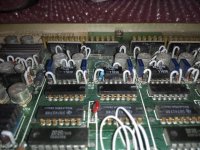acollins22
Experienced Member
Hi Folks,
In this recent thread I mentioned this I'd got a Canadian PDP-8 clone.
I am in the process of restoring it and have checked out the power supplies and given the boards that make up the CPU and clean and visual check.
I have now moved on to the core memory boards and have run across a snag I hope someone can help me with.

Inspecting on of the two core memory boards I noticed a broken resistor on the board.
In the hope of finding out what value it is I turned to the other identical core memory board and it has the same fault on the same resistor. Talk about identical.

So here's is my problem. How do I identify this resistor? I have a photo but I can't see a tolerance band so I'm not sure which way to read it. Could it really be a 50 Ohm resistor?
Can someone suggest a way forward?
Thanks,
Andy.
In this recent thread I mentioned this I'd got a Canadian PDP-8 clone.
I am in the process of restoring it and have checked out the power supplies and given the boards that make up the CPU and clean and visual check.
I have now moved on to the core memory boards and have run across a snag I hope someone can help me with.

Inspecting on of the two core memory boards I noticed a broken resistor on the board.
In the hope of finding out what value it is I turned to the other identical core memory board and it has the same fault on the same resistor. Talk about identical.

So here's is my problem. How do I identify this resistor? I have a photo but I can't see a tolerance band so I'm not sure which way to read it. Could it really be a 50 Ohm resistor?
Can someone suggest a way forward?
Thanks,
Andy.

